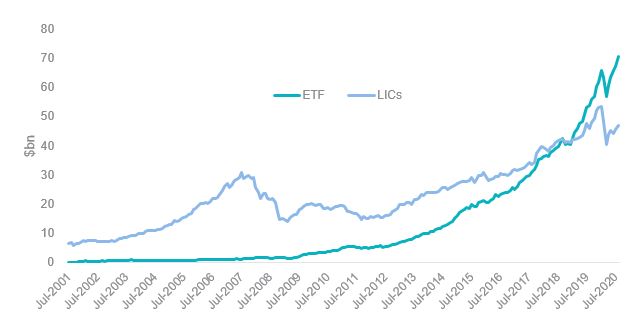There won’t be any new LICs
The number of listed investment companies (LIC) and their assets under management are falling this year. This is in contrast to the exchange-traded product (ETP) sector which is surging ahead with new issues and investment inflows. There are a few key reason for this.
As at 31 August 2020, the LIC sector, which includes listed investment trusts, had a total market capitalisation of about $46.8 billion across around 110 listed products, down 14.3% from $53.5 billion in January 2020. That represents a significant fall of about 18%, while the number of funds had fallen from 113 according to an analysis if ASX data.
In contrast, the Australian ETP industry had jumped to a market capitalisation of $70.5 billion as at August 31, up 7.3% from $65.7 billion in January 2020. That highlights the appeal of exchange traded funds (ETFs), which make up almost 90% of the ETP industry. ASX data shows the number of ETPs as of 31 August 2020 is 234, a jump from 211 in January 2020.
We think in all likelihood, the LIC market is going to continue to contract. Some of the LICs launched decades ago with low fees could survive, but the more recently launched LICs could either be terminated or be restructured. We’ve already seen three disappear from the market this year. No new LICs have been issued.
In contrast, the ETP market is now bigger than the LIC sector – having extended this lead since the March share market correction. The restructuring and termination of LICs occurred after the GFC, but this time LICs won’t resurrect so easily as controversial stamping fees have (again) been banned, which had been a significant driver of the sector’s growth.
Source: ASX, VanEck as at 31 August 2020
The LIC market is now being treated on a more level playing field in line with unlisted managed funds and ETPs, as LIC sector sales commissions (payable to advisers) were banned July this year; restating the (short-lived) ban in 2012.. Now, there is less incentive for advisers to recommend LIC’s, and their popularity has waned.
The COVID-19 induced market sell-off in March has also hit the LIC sector hard, with many of the funds trading at significant discounts, a sign they are falling out of favour.
Liquidity in the LIC sector also dried up in March 2020 during the COVID-19 sell-off and has remained lower despite the recovery in share markets. Indeed, inflated discounts on many LICs remain, some as high as 15% or 20% on various larger LICs[1] amid liquidity problems in the sector. This is a sign that there is less demand coming from investors.
ETFs offer investors a superior alternative. ETFs are more liquid, lower cost and transparent. Investors don't need thousands of dollars to make an investment and can buy and sell the exact amount they need on the Australian Securities Exchange. No longer will Australian investors be as willing to accept poor liquidity or returns from LICs, and nor will they accept high fees. ETFs are positioned to grab even greater market share through the remainder of 2020.
Published: 07 October 2020
Issued by VanEck Investments Limited ACN 146 596 116 AFSL 416755 (‘VanEck’). This is general advice only, not personal financial advice. It does not take into account any person’s individual objectives, financial situation or needs. Read the PDS and speak with a financial adviser to determine if the fund is appropriate for your circumstances. PDSs are available here and details the key risks. No member of the VanEck group of companies guarantees the repayment of capital, the payment of income, performance, or any particular rate of return from any fund




